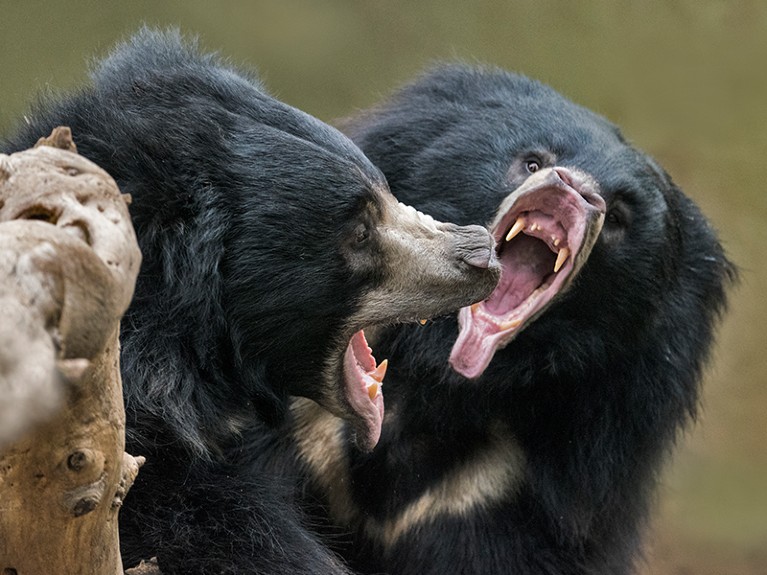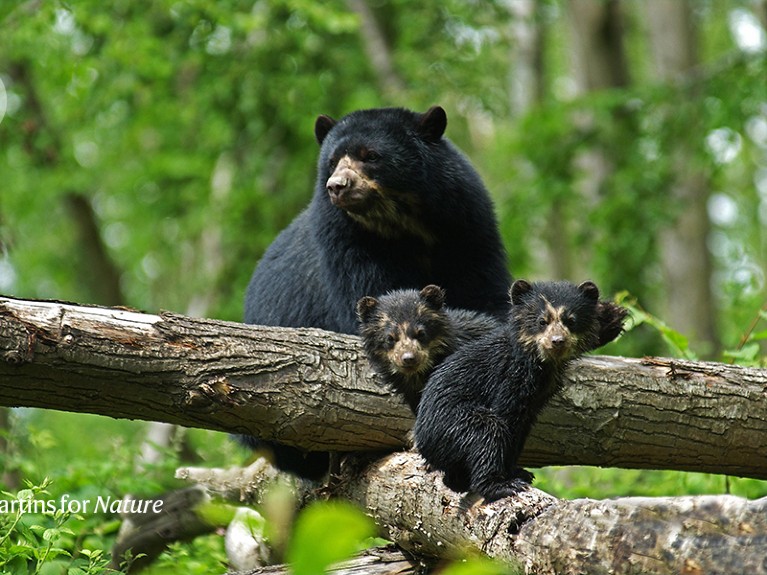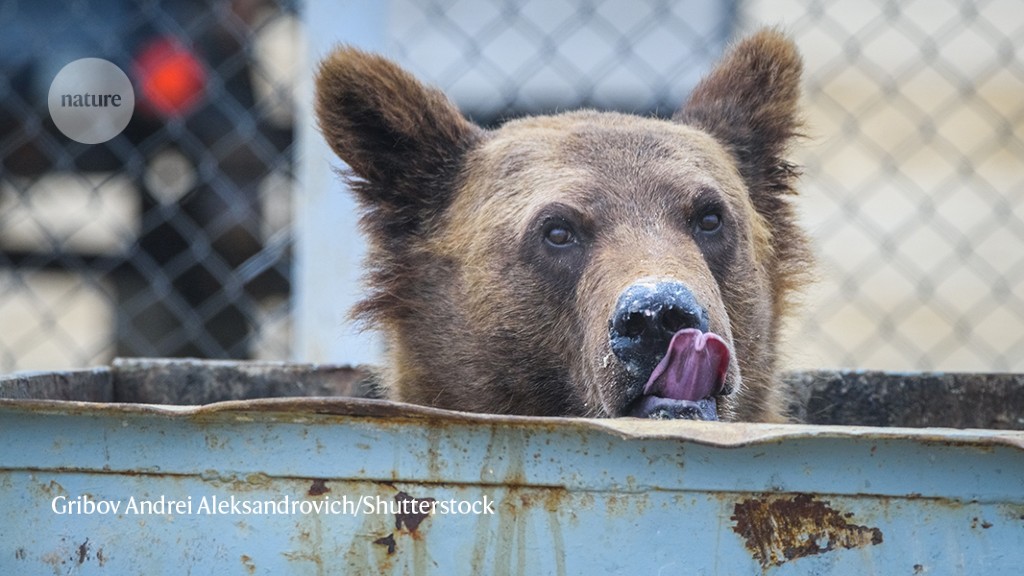
Brown bears are drawn to urban areas by food waste in open bins.Credit: Gribov Andrei Aleksandrovich/Shutterstock
Eight Bears: Mythic Past and Imperiled Future Gloria Dickie W. W. Norton (2023)
The probability of seeing a giant panda in the wild is practically nil. Even if you were to spend weeks trekking through the dripping bamboo forests of Sichuan, China, hoping to catch a glimpse of the famous black-and-white bear, there’s a good chance you would still not see one.
This was a problem environmental journalist Gloria Dickie encountered as she travelled from South America to Asia to North America and the Arctic, doing research for her book Eight Bears. Her encounters with wild bears were few and typically in urban landscapes, so her account is more about the relationship between humans and bears than it is about the animals themselves. It’s an engaging travelogue nonetheless, weaving together evolutionary biology, physiology, ecology, history, culture, economics and politics to reveal the importance of each ursine species to our own. In doing so, the book highlights how the damage humans have done to the world poses a challenge to animals.
In crude terms, the eight bear species divide into two categories. Some have a large cultural footprint, because they are conservation icons or common subjects of films and television (the giant panda, Ailuropoda melanoleuca; the American black bear, Ursus americanus; the brown bear, Ursus arctos; and the polar bear, Ursus maritimus). Others are not so familiar (the spectacled, or Andean, bear, Tremarctos ornatus; the sloth bear, Melursus ursinus; the Asiatic black bear, Ursus thibetanus; and the sun bear, Helarctos malayanus). It is Dickie’s accounts of these lesser-known bears that are most surprising.
Dwelling in the clouds
In Cusco, Peru, Dickie teams up with scientists who use camera traps to spy on shy Andean bears. As the climate warms, these black bears with spectacle-like rings of brown fur around their eyes are retreating ever higher into the cloud forests, where they are becoming trapped at high altitudes. The fogged and mossy cloud forests are slowly becoming drier, with more than half expected to be lost by the middle or end of this century (E. H. Helmer et al. PLoS ONE 14, e0213155; 2019). If climate change cannot be slowed, the bears will run out of mountain. The scientists hope to learn more about the behaviour of these elusive animals — in particular, why they are not moving to lower altitudes.
In India, Dickie hears horror stories about the world’s most dangerous bear — the sloth bear, which can rear up onto its hindlegs and use its long, knife-like claws to inflict savage injuries. Although there are probably fewer than 20,000 sloth bears left in Asia, the author reports that they are responsible for around 150 attacks on humans each year. Understandably then, there’s not a lot of love lost for the sloth bear. “Too shaggy and sloppy to be respected for its physical powers … and excluded from the huggable genre to which the panda and the sun bear belong”, the sloth bear has a short temper that “poses an almost insurmountable challenge in the ethos of human—wildlife coexistence,” writes Dickie. With few people prepared to think strategically about conserving this vulnerable species, it’s likely that its numbers will decline as deforestation and the human population in India continue to grow.

Attacks by aggressive sloth bears are increasing in India as the booming human population strays into the bears’ habitat more often.Credit: Mark Newman/Getty
Asiatic black bears (also called moon bears) and sun bears face a more direct human threat. Across Asia, traders capture and illegally farm these animals for bear bile, which is regarded by some as a treatment for a host of ailments. According to the book, this distressing trade is currently thought to involve more than 20,000 bears. Dickie poses as a foreign investor interested in getting into the bile business. Her real aim is to raise awareness of its torturous techniques, such as the crushing cages that animals are housed in, often for life, and the cruel methods used to extract the bile, which can include a painful process to establish a permanent tunnel into the gallbladder.
Despite this commonality, it is frustrating that Dickie bundles sun bears and moon bears into a single chapter. Although they look similar — black with a crescent of pale fur on their chests — they are highly distinct species that diverged some 4.5 million years ago (V. Kumar et al. Sci Rep. 7, 46487; 2017). Dickie’s decision probably reflects a lack of material about the sun bear, which is little studied because of its penchant for hiding high up in dense vegetation, out of sight of humans and their dart guns.
Iconic bears
Each of the other chapters brings with it a different take on our relationship with bears. “In a largely agnostic society, the panda, it seems, has ascended to be China’s greatest cultural deity,” writes Dickie, as she explores the animal’s extraordinary attraction. The American black bear, with a global population of around one million, offers a case study in whether humans can manage the tensions that arise from living alongside bears. It’s an expensive and never-ending process of education and bear management, but testimonies from staff at Yosemite National Park indicate that it is possible.

The lush cloud forests where Andean bears live are drying out.Credit: Getty
Dickie uses aggressive brown bears to examine arguments for and against trophy hunting. She meets conservationists who have worked hard to bring the species back from the brink of extinction, and ranchers and hunters keen to see it delisted from the US Endangered Species Act. In the Arctic, she writes about how, with a rapidly declining population of 26,000, the polar bear is “one of the Anthropocene’s most charismatic victims”. Sea-ice coverage is diminishing at such an alarming rate that, even in the best-case scenario, there might be no polar bears left in the wild by the end of this century.
With teddy bears and lovable TV characters such as Paddington Bear, Yogi Bear and Baloo common features of childhood, it is understandable that many people have a fondness for bears. But with the futures of their real cousins at stake, it is “a luxury”, writes Dickie, “to conceive of these animals as fable protagonists, majestic arbiters of wilderness, and cuddly cartoon characters.” Through Dickie’s personal journey and her interviews, Eight Bears delivers on its promise to offer “an unromanticized view of bears’ tenuous position in the Anthropocene”.
Competing Interests
The author declares no competing interests.




More News
US funders to tighten oversight of controversial ‘gain-of-function’ research
Bird flu in US cows: where will it end?
Daily briefing: Why exercise is good for us